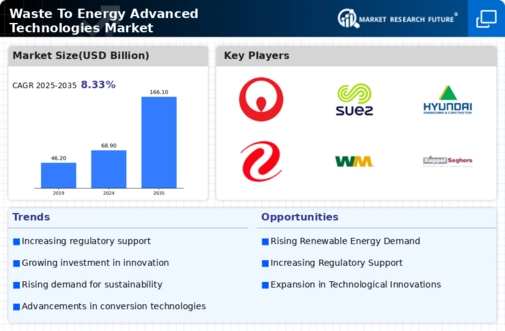Waste To Energy Advanced Technologies Market Summary
The Global Waste To Energy Advanced Technologies Market is projected to grow significantly from 68.86 USD Billion in 2024 to 166.06 USD Billion by 2035.
Key Market Trends & Highlights
Waste To Energy Advanced Technologies Key Trends and Highlights
- The market is expected to experience a compound annual growth rate (CAGR) of 8.33 percent from 2025 to 2035.
- By 2035, the market valuation is anticipated to reach 166.1 USD Billion, indicating robust growth potential.
- in 2024, the market is valued at 68.86 USD Billion, reflecting a strong foundation for future expansion.
- Growing adoption of advanced waste conversion technologies due to increasing environmental regulations is a major market driver.
Market Size & Forecast
| 2024 Market Size | 68.86 (USD Billion) |
| 2035 Market Size | 166.06 (USD Billion) |
| CAGR (2025-2035) | 8.33% |
Major Players
Veolia, SUEZ, Hyundai Engineering Construction, Xcel Energy, Waste Management, China Everbright International Limited, Foster Wheeler, Doosan Heavy Industries Construction, Hitachi Zosen Inova AG, Suez Environnement, Veolia Environnement, Keppel Seghers, Covanta Holding Corporation, SEPCOIII Electric Power Construction, Abengoa Solar, Babcock Wilcox Enterprises, Mitsubishi Heavy Industries


















Leave a Comment